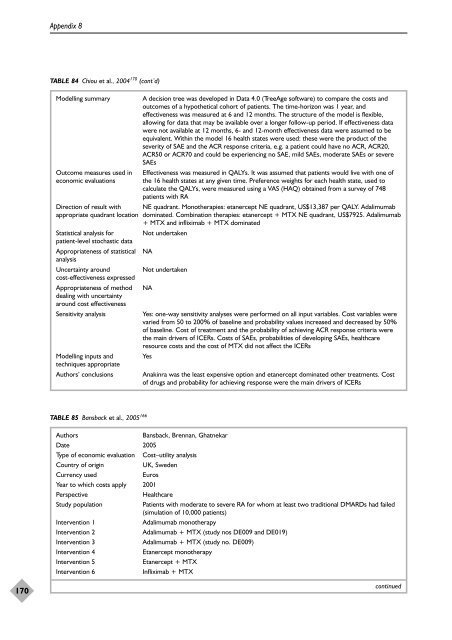A systematic review of the effectiveness of adalimumab
A systematic review of the effectiveness of adalimumab
A systematic review of the effectiveness of adalimumab
Create successful ePaper yourself
Turn your PDF publications into a flip-book with our unique Google optimized e-Paper software.
170<br />
Appendix 8<br />
TABLE 84 Chiou et al., 2004 170 (cont’d)<br />
Modelling summary A decision tree was developed in Data 4.0 (TreeAge s<strong>of</strong>tware) to compare <strong>the</strong> costs and<br />
outcomes <strong>of</strong> a hypo<strong>the</strong>tical cohort <strong>of</strong> patients. The time-horizon was 1 year, and<br />
<strong>effectiveness</strong> was measured at 6 and 12 months. The structure <strong>of</strong> <strong>the</strong> model is flexible,<br />
allowing for data that may be available over a longer follow-up period. If <strong>effectiveness</strong> data<br />
were not available at 12 months, 6- and 12-month <strong>effectiveness</strong> data were assumed to be<br />
equivalent. Within <strong>the</strong> model 16 health states were used: <strong>the</strong>se were <strong>the</strong> product <strong>of</strong> <strong>the</strong><br />
severity <strong>of</strong> SAE and <strong>the</strong> ACR response criteria, e.g. a patient could have no ACR, ACR20,<br />
ACR50 or ACR70 and could be experiencing no SAE, mild SAEs, moderate SAEs or severe<br />
SAEs<br />
Outcome measures used in Effectiveness was measured in QALYs. It was assumed that patients would live with one <strong>of</strong><br />
economic evaluations <strong>the</strong> 16 health states at any given time. Preference weights for each health state, used to<br />
calculate <strong>the</strong> QALYs, were measured using a VAS (HAQ) obtained from a survey <strong>of</strong> 748<br />
patients with RA<br />
Direction <strong>of</strong> result with NE quadrant. Mono<strong>the</strong>rapies: etanercept NE quadrant, US$13,387 per QALY. Adalimumab<br />
appropriate quadrant location dominated. Combination <strong>the</strong>rapies: etanercept + MTX NE quadrant, US$7925. Adalimumab<br />
+ MTX and infliximab + MTX dominated<br />
Statistical analysis for Not undertaken<br />
patient-level stochastic data<br />
Appropriateness <strong>of</strong> statistical NA<br />
analysis<br />
Uncertainty around Not undertaken<br />
cost-<strong>effectiveness</strong> expressed<br />
Appropriateness <strong>of</strong> method NA<br />
dealing with uncertainty<br />
around cost <strong>effectiveness</strong><br />
Sensitivity analysis Yes: one-way sensitivity analyses were performed on all input variables. Cost variables were<br />
varied from 50 to 200% <strong>of</strong> baseline and probability values increased and decreased by 50%<br />
<strong>of</strong> baseline. Cost <strong>of</strong> treatment and <strong>the</strong> probability <strong>of</strong> achieving ACR response criteria were<br />
<strong>the</strong> main drivers <strong>of</strong> ICERs. Costs <strong>of</strong> SAEs, probabilities <strong>of</strong> developing SAEs, healthcare<br />
resource costs and <strong>the</strong> cost <strong>of</strong> MTX did not affect <strong>the</strong> ICERs<br />
Modelling inputs and Yes<br />
techniques appropriate<br />
Authors’ conclusions Anakinra was <strong>the</strong> least expensive option and etanercept dominated o<strong>the</strong>r treatments. Cost<br />
<strong>of</strong> drugs and probability for achieving response were <strong>the</strong> main drivers <strong>of</strong> ICERs<br />
TABLE 85 Bansback et al., 2005 166<br />
Authors Bansback, Brennan, Ghatnekar<br />
Date 2005<br />
Type <strong>of</strong> economic evaluation Cost–utility analysis<br />
Country <strong>of</strong> origin UK, Sweden<br />
Currency used Euros<br />
Year to which costs apply 2001<br />
Perspective Healthcare<br />
Study population Patients with moderate to severe RA for whom at least two traditional DMARDs had failed<br />
(simulation <strong>of</strong> 10,000 patients)<br />
Intervention 1 Adalimumab mono<strong>the</strong>rapy<br />
Intervention 2 Adalimumab + MTX (study nos DE009 and DE019)<br />
Intervention 3 Adalimumab + MTX (study no. DE009)<br />
Intervention 4 Etanercept mono<strong>the</strong>rapy<br />
Intervention 5 Etanercept + MTX<br />
Intervention 6 Infliximab + MTX<br />
continued
















